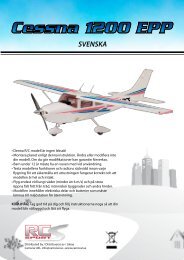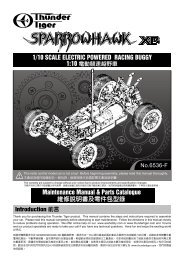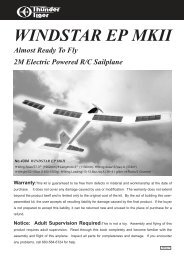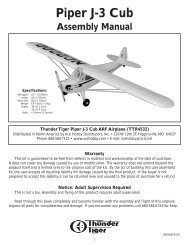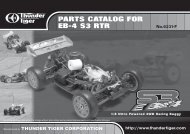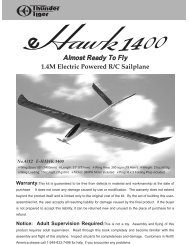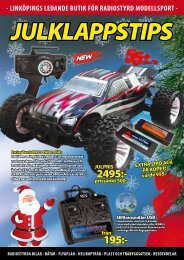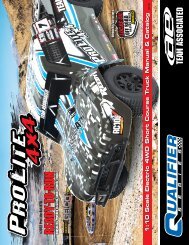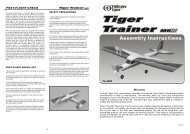Raptor 30 V2 - DMT
Raptor 30 V2 - DMT
Raptor 30 V2 - DMT
Create successful ePaper yourself
Turn your PDF publications into a flip-book with our unique Google optimized e-Paper software.
with a liability insurance plan as well as monthly magazine entitled Model Aviation. All<br />
AMA charter aircraft clubs require all pilots to hold a current AMA sporting license prior<br />
to operation of their models at club fields. For further information, contact the AMA at:<br />
Academy of Model Aeronautics<br />
5151 East Memorial Drive<br />
Muncie, IN 47<strong>30</strong>2<br />
(317) 287-1256<br />
FLIGHT SAFETY CHECKLIST<br />
1. Make sure both the transmitter and receiver batteries are fully charged prior to operation the<br />
helicopter.<br />
2. Make sure all flight controls operate properly prior to flying.<br />
3. Range check the radio before the first flight. The servos must operate properly with the<br />
transmitter antenna collapsed at a range of at least 50 ft.(15 meters).<br />
4. Check to make sure there is no radio interference on your radio channel before operating<br />
the helicopter.<br />
5. Use only the recommended engine fuel as specified by the engine manufacturer.<br />
6. Make sure the transmitter and receiver are turned on before starting the engine.<br />
7. The engine throttle must be in the idle position before starting the engine.<br />
8. Model helicopter main and tail rotors operate at high RPM. Make sure nothing can come in<br />
contact with the rotor blades during flight.<br />
9. After starting the helicopter, maintain a safe distance during the flight.<br />
10. Never operate the helicopter in rain or excessive wind conditions.<br />
11. Always operate and fly your helicopter in a safe and responsible manner.<br />
12. Never fly a model helicopter over other pilots, spectators or cars.<br />
POST FLIGHT INSPECTION<br />
1. Inspect the model thoroughly to insure no parts have come loose or become damaged during<br />
the flight and landing. Replace damaged parts and tighten loose screws before flying again.<br />
2. Pump out any remaining fuel from the fuel tank.<br />
3. Wipe off excess oil and fuel from helicopter body and other exposed parts.<br />
4. Lubricate all moving parts ensure smooth operation for the next time you fly.<br />
5. Store model in a cool, dry place. Avoid storage in direct sunlight or near a source of heat.<br />
Following these few, simple safety rules will allow you to enjoy the thrill of model helicopter flying<br />
for many years to come.<br />
2



